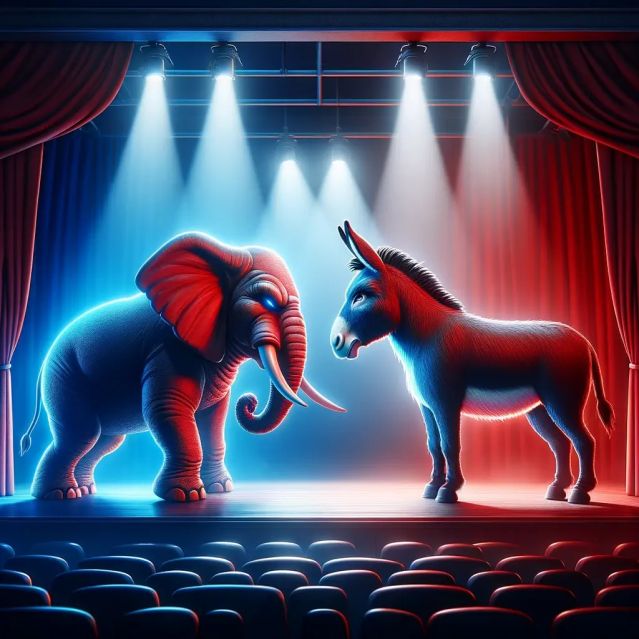Politics
The Art of Politics and the Use of Campaigns as Theater
Can aesthetic experiences frame presidential campaigns?
Posted September 13, 2024 Reviewed by Tyler Woods
Key points
- Political campaigns are political theater of the first order.
- Scientific aesthetics can help frame campaign strategies that evoke emotions to persuade voters.
- Aesthetic impacts broadly entail states of positive affect, negative affect, immersion, and transformation.
- These impacts accord with the heightened emotions strategically cultivated in high-stakes political drama.

Campaigns as theater
If all the world’s a stage, as the Bard would have it, surely some performances are more gripping than others. Some even threaten to upend our lives. To apply the stage metaphor, we are now faced with political theater of the first order. The U.S. presidential campaigns, after party convention pageantry and debate drama, are moving into their final act. Political professionals and junkies have been scrutinizing these performances for a while. Others are just beginning to wake up to the unfolding spectacle.
A couple of months ago, the Democrats were glum. The presidential campaign felt plodding and uninspired. The Republicans were triumphant. They entered their national convention with a messianic confidence buoyed by a failed assassination attempt. In a few weeks, the vibes changed dramatically. With a change in lead actors, the Democrats were energized, the Republicans regrouping. Much can still change before November 4th. Yet, within this plot, replete with twists and turns, are there emotional and cognitive throughlines that help us frame the campaigns?
Scientific aesthetics
Another form of this question is: can research in scientific aesthetics conceptualize the unfolding campaigns in fresh terms? Campaign advertisements, party rallies, and press coverage are now inundated with evocative words like weird, creepy, weak, and dangerous. These words frame how each party wants the public to feel about the other side.
At first pass, mapping political strategy to aesthetics might seem like a category mistake. On the contrary, aesthetic experiences are embedded in everyday life, with the frenzied election campaign being no exception. Our work in empirical aesthetics offers a way to understand how campaigns try to influence the public. To be clear, the ideas I propose are probably self-evident to campaign strategists and long-term political observers. They might, however, offer a useful framework for the politically naïve now facing an onslaught of claims and counterclaims.
In scientific aesthetics, we ask, "What kind of impact can aesthetic engagements have on a viewer?" In pursuing this question, we identified a taxonomy based on input from aesthetics experts and crowd-sourced associations of potential cognitive and emotional impacts (Christensen, Cardillo, & Chatterjee, 2023). This taxonomy consists of a semantic map of 69 terms. The 69 words cluster into 11 dimensions, and the 11 dimensions can be further reduced (statistically) to four coarse categories. These four categories of cognitive and emotional impacts are positive affect (e.g., pleasure, compassion, calm), negative affect (e.g., angry, upset, challenged), attention (e.g., interest, enraptured), and a change in understanding (or epistemic transformation, e.g., inspired, edified, enlightened).
Mapping aesthetic impacts on campaigns
How might these categories apply to political campaigns? The first two impacts, positive and negative affect, apply to broad strategies. The last two apply to the outcomes of those strategies, with attention being more relevant to a party’s political base and transformation to undecided voters.
Positive and negative affect are straightforward. Campaigns want to frame themselves in a positive light and the other side in a negative one. One side is joyful, the other dour. One side is strong, the other weak. Campaigns lean into their positives and emphasize the other’s negatives in some proportion deemed effective by their strategists.
Reagan’s “Morning in America” and Obama’s “Yes, we can,” conveyed a confident, optimistic future for the country with them at the helm. One side expresses sympathy, the other tries to convey strength. On the negatives, scare-mongering rules. Lyndon Johnson’s “Daisy” ad showed a young girl counting petals followed by a nuclear explosion, suggesting that Goldwater was too extreme to be trusted with nuclear weapons, and George H.W. Bush’s Willie Horton advertisement used racial undertones to highlight Dukakis’s prison furlough program to exploit fear and anger in a public anxious about crime. Now, not only are immigrants stealing your jobs, they are eating your pets.
Campaigns care about how much attention they garner. Many Americans only start to think about presidential politics in the last few months leading up to the election. Rallies whip up interest. TV appearances and press coverage compete for a public with limited attention. Contentious discussions of relative crowd sizes and their enthusiasm at rallies speak to the importance candidates and the press give to this measure of a campaign’s vitality. After delivering a cocktail of positive and negative emotional impacts, has a campaign captured the attention and imagination of their constituents? This enthusiasm presumably translates into turning out the votes of their base. In battleground states with narrow margins, turnout among the faithful could make a difference.
The final important group of voters are those who are undecided. At this point, more American citizens are independent than are registered as Democrats or Republicans. Some do not find that either party addresses their concerns, whether those concerns are about our support of international wars or expressions of a callous apathy towards the disenfranchised and displaced. The number of undecided does not mean that some people in this group do not lean in one direction or the other. It does mean, again in battleground states, swaying a small group of undecided voters could make a big difference. How might they be transformed? Playing on these people’s emotions more than their reasoning, campaigns try to change their view of political affairs or mitigate their concerns to persuade them to vote for their champion. Don’t worry. We will protect your freedoms and preserve a country you cherish. We will make your life easier by containing the costs of living and helping your community flourish. The focus is on how you, the voter’s life, will change and improve because of what we do.
And so the story goes. The emotions evoked are designed to make voters believe: we are good, they are bad, we represent you, your life will be better because of us. Some may say politics is ugly business. For others, a theater of the absurd. Either way, it is an aesthetic experience that stirs the passions of millions of Americans every four years. Political campaigns are high-stakes dramas whose heightened emotions are made clearer through the lens of scientific aesthetics.
References
Christensen, A. P., Cardillo, E. R., & Chatterjee, A. (2023). What kind of impacts can artwork have on viewers? Establishing a taxonomy for aesthetic impacts. British journal of psychology, 114(2), 335-351. https://doi.org/10.1111/bjop.12623




